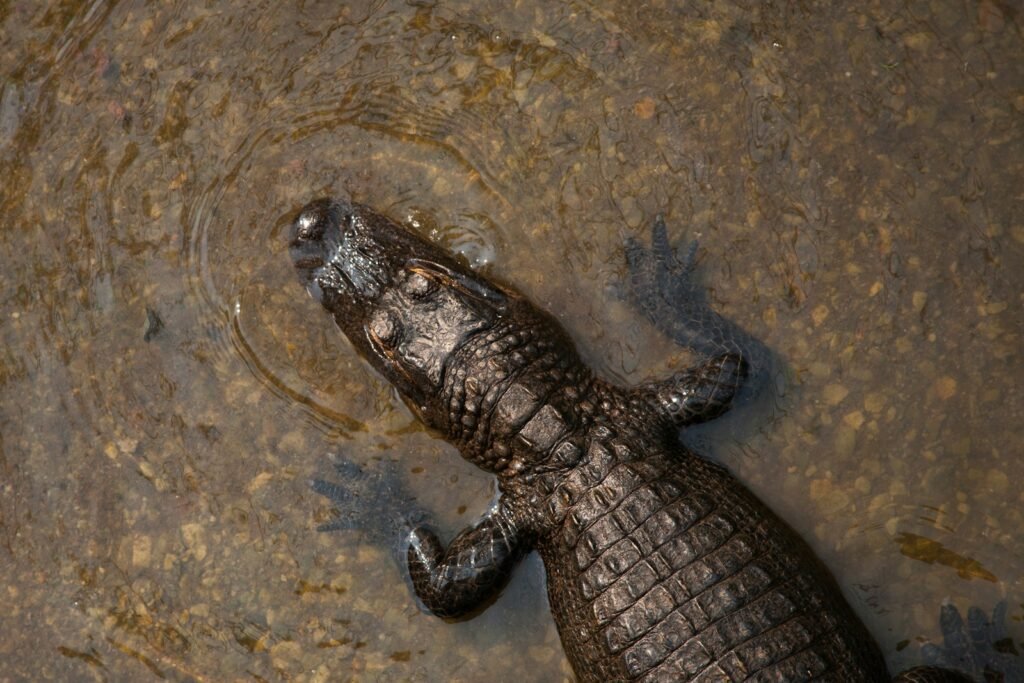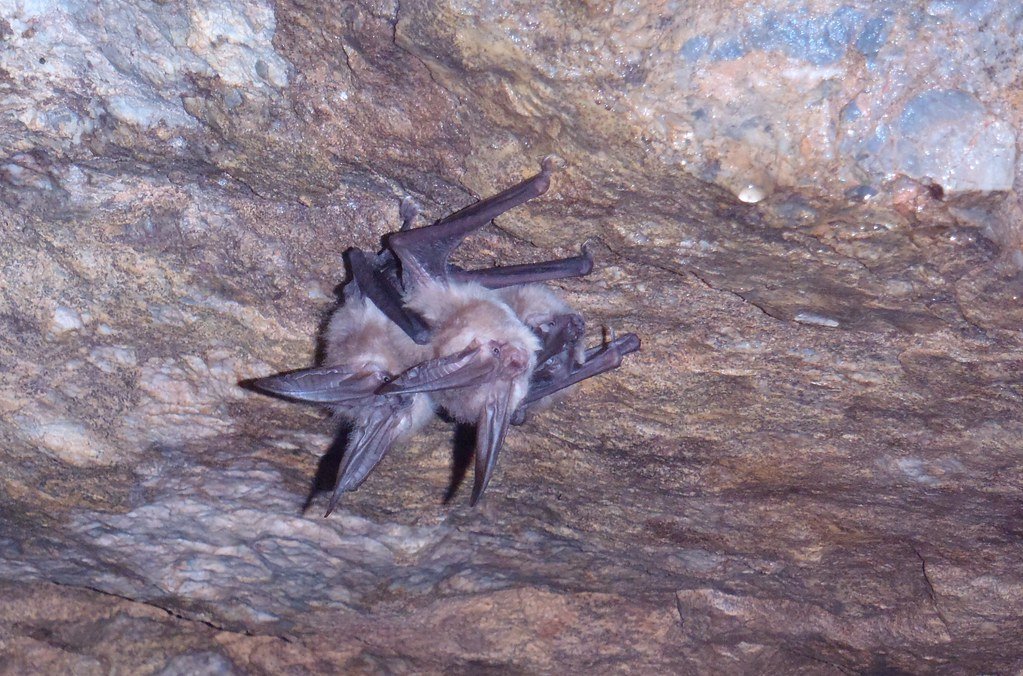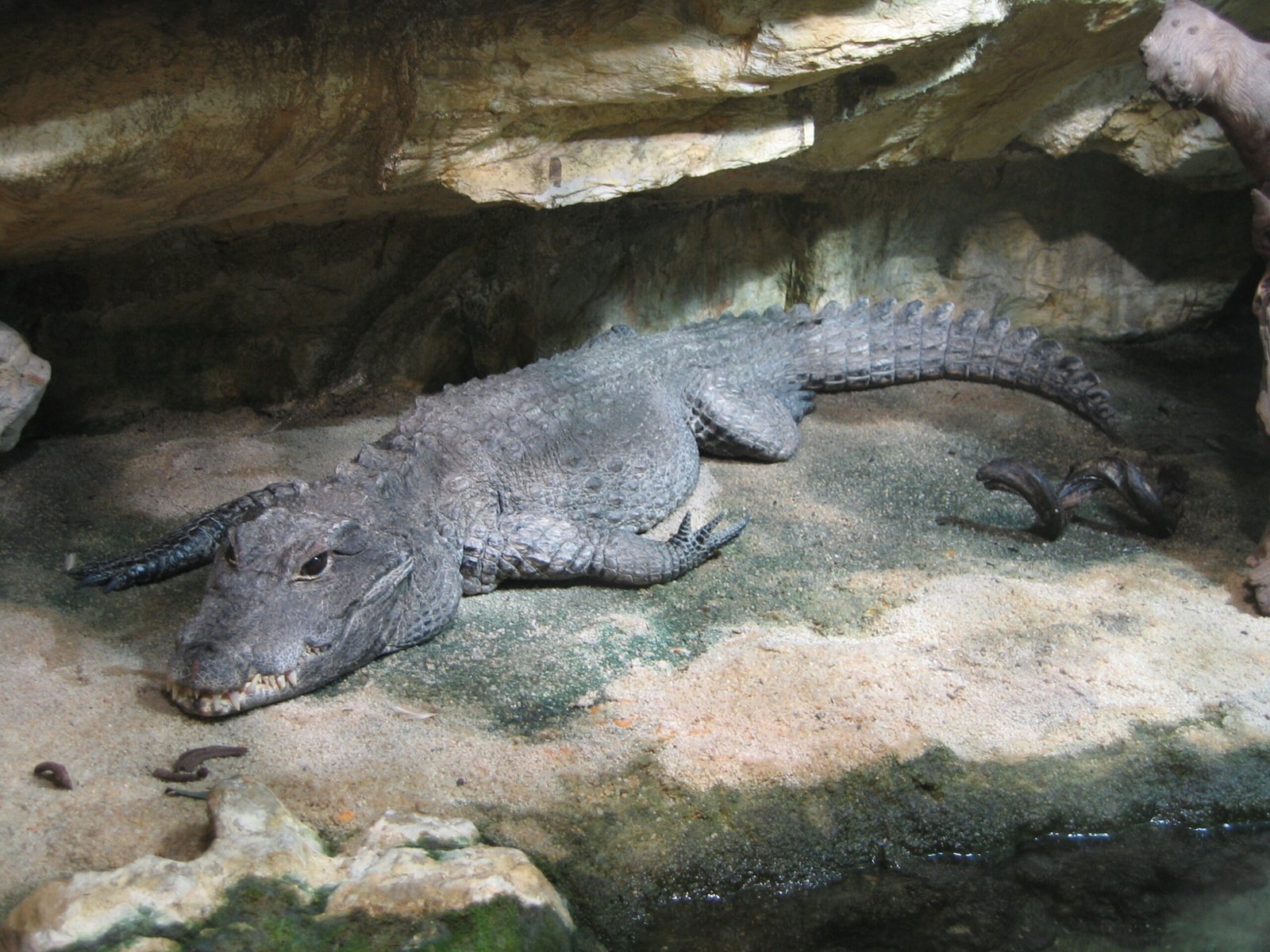Picture this: you’re rappelling into the steaming depths of a West African cave, headlamp cutting through pitch-black air thick with noxious fumes. Your boots sink into what looks like chocolate pudding but smells far worse. Then, from the darkness ahead, you glimpse something impossible – the amber eyes of a crocodile, glowing orange like a forgotten ember in this subterranean hellscape.
The Discovery That Changed Everything

The cave crocodiles were first found in 2008 by archaeologist Richard Oslisly. What started as an archaeological expedition to search for ancient human artifacts in Gabon’s remote cave systems turned into one of the most remarkable biological discoveries of the 21st century. The Abanda cave complex, located in the upstream of Fernan Vaz Lagoon, held secrets that nobody expected to find. Hidden beneath the canopy of Gabon’s dense rainforest, these caves harbored not just ancient human history, but living, breathing evidence of evolution in action. Deep inside one of Gabon’s cave systems lives an unusual population of orange dwarf crocodiles. They live in complete darkness, feast on bats and swim in liquid guano (aka bat poop.) It’s unknown how many crocodiles are living in these caves, or when they adopted this subterranean lifestyle, but they may have been down there for thousands of years — and scientists say they may even be in the process of evolving into a new species. The discovery sent shockwaves through the scientific community because, quite simply, crocodiles weren’t supposed to live like this.
A Nightmare Environment That Somehow Sustains Life

“The Abanda cave system in Gabon is not a place you want to live. In the belly of the caves, it’s pitch black and hot. Fumes circulating inside tend to cause nausea. And cavers have to wade through sludge.” Cave scientist Olivier Testa describes conditions that would make even the hardiest explorer think twice. “It looks like liquid mud,” says cave scientist Olivier Testa, “but it’s not mud.” It’s bat guano. A lot of it. Mixed with water, it becomes viscous pools of bat feces. The air is thick with ammonia and carbon dioxide, creating an atmosphere that’s borderline toxic to humans. Yet somehow, in this biological nightmare, an entire ecosystem thrives. “It’s an extremely harsh environment,” says herpetologist Matthew Shirley. “When we leave the caves, we’re wiped.” The temperatures hover around a stifling 86°F (30°C) with humidity levels approaching 100%, creating a steam bath effect that quickly exhausts even experienced cavers.
The Orange Transformation: When Chemistry Meets Biology

Perhaps the most striking feature of these cave-dwelling crocodiles is their supernatural orange coloration. Some of the large, male crocodiles are also orange, but this is unlikely a genetic mutation and more likely a result of soaking in bat poop. “Bat guano is largely comprised of urea,” a nitrogen-rich chemical found in urine, says Shirley. “When they’re sitting in this bat guano slushie, we think the highly basic pH water is tanning their skin.” This isn’t just a superficial staining – the chemical process actually erodes the crocodiles’ skin over time. “We hypothesize that the orange coloration in large adults is caused by ‘bleaching’ of the skin after what is presumably years of inundation in bat guano,” the researchers say. In some cases, they found, the guano isn’t just bleaching the crocs’ skin and changing its color, but eroding it to the point where the scientists could clearly see the animals’ skulls peeking out through the skin. It’s like living in a chemical bath that slowly transforms you from the outside in, yet these remarkable creatures not only survive but thrive in conditions that would be lethal to most life forms.
A Diet Revolution: From Fish to Flying Mammals

The crocodiles’ survival strategy required a complete dietary overhaul. Unlike the forest-dwelling dwarf crocodiles, which feed on fish and crustaceans, the cave population primarily eats bats. This represents one of the most dramatic dietary shifts documented in crocodilian species. “There are tens of thousands of bats [in the caves],” he adds. The caves provide an all-you-can-eat buffet of hanging protein. And when the researchers analyzed the stomach content of cave crocodiles, they found bat skeletons and fur mixed with crickets. While the forest crocs barfed up freshwater crabs, shrimp, crayfish, and a variety of insects, the cave crocodiles were eating cave crickets and bats—and little else. The difference in diets, the researchers say, suggests that cave crocodiles don’t hunt or feed aboveground and likely have very little contact with their neighbors. It’s like discovering a population of vegetarian sharks – it completely upends what we thought we knew about these ancient predators.
The Genetic Mystery: Are We Witnessing Speciation?

African dwarf crocodiles, to be exact, are found above ground throughout Gabon, but the cave-dwelling population has developed a unique genetic signature unmatched by its topside counterparts, says Shirley. Blood samples collected from the cave crocodiles revealed something extraordinary happening at the molecular level. To test this, the researchers tested blood samples from the crocodiles found in the caves, and compared them with forest-dwelling crocs living outside in the area. It turned out the cave dwelling crocs have different genetic haplotype, which means that the reptile is adapting or mutating to life in the dark. The first DNA analysis made in 2010 showed a genetic difference of a few percents between the crocodile inside the caves and the crocodile found elsewhere in Gabon. The population has therefore been isolated for several thousands years. Several hundred generations would have been needed to develop such distinct genetic markers, and with dwarf crocodiles capable of living 50 to 100 years, this isolation may stretch back millennia.
Physical Adaptations: Evolution in Fast Forward

Crocodiles are normally diurnal and depend on sunlight to regulate their metabolism, but most of these crocodiles will go without sunlight for decades of their life. This represents a fundamental shift in how these reptiles function as living organisms. Their bodies have had to adapt to a world without the solar energy that normally powers their cold-blooded metabolism. Juvenile cave crocodiles had significantly higher body condition compared to juvenile forest crocodiles, which did not vary amongst forest locations. The difference in body condition between adult cave and forest crocodiles was not statistically significant despite also being higher. Paradoxically, despite living in what appears to be a hostile environment, the cave crocodiles are actually healthier than their surface-dwelling cousins. After taking all the animals’ measurements, the researchers found that the cave crocodiles were in better physical condition than any of the crocs living aboveground. The team thinks this is because the cave crocs’ prey—bats and crickets—is abundant (numbering in the tens of thousands), easy to catch, and available year-round.
The Underground Architecture: A Natural Prison Turned Paradise

The caves are fossil karstic conduits developping in cretaceous limestone along two main directions, says geologist David Sebag. The orientation are consistent with the major fault system that structures Gabon. These ancient geological formations create a maze-like network of interconnected chambers and passages. Abanda Caves are a great example of a tropical karst system, resulting from the dissolution of limestone bedrock by rainfall. They have been formed over thousands of years through both physical and chemical weathering which cause the disintegration of the rocks. The Abanda cave network is based on a system of faults. Some of the crocodiles live completely isolated from the exterior, the only access being through a 7 m deep shaft. What makes this system particularly fascinating is that many of the crocodiles appear to be completely trapped – they fell in but can’t get out. The caves function like natural pitfall traps, but instead of dying, the crocodiles adapted and thrived.
The Mystery of Entry and Exit

They suggest the cave crocodiles lay their eggs at the mouth of the caves, then the juveniles venture into the darkness. Once they reach adulthood, it’s thought they barely leave the caves again. This creates a fascinating life cycle where the animals start their lives in sunlight but gradually migrate deeper into eternal darkness as they mature. Shirley theorizes that a small number of individuals from the outside finds their way into the cave in every generation. How they might be entering or exiting, however, is unclear. We think that entrances existed in the past, but they are now filled with sediments, preventing the crocodiles to escape. One question needs also to be solved, the reason why these crocodiles initially found shelter in these caves. Some scientists speculate that climate change thousands of years ago may have driven the ancestors of these crocodiles underground in search of stable conditions.
The Bat Connection: A Symbiotic Ecosystem

More than 50.000 bats live in Dinguembou Cave, and they fly at dusk every day to feed on fruits. The caves host massive colonies of different bat species, creating a complex aerial ecosystem above the aquatic crocodile habitat. This caves hosts several bat colonies of different species (Rousettus aegyptiacus, Hipposideros aff. ruber, et Hipposideros aff. Gigas). The relationship between bats and crocodiles in these caves represents one of nature’s most unusual predator-prey dynamics. Unlike surface environments where crocodiles must actively hunt in water, the cave crocodiles essentially wait for dinner to fall from the ceiling. The bat guano that covers the floor contains myriads of invertebrates, and a sampling of this soil fauna have been made. The biodiversity of the caves of Gabon has never been studied before. The entire ecosystem is built on this foundation of bat waste, creating a food web unlike anything found elsewhere on Earth.
Population Dynamics: A Small World Underground

The current population size is not more than 100-200 individuals, according to Shirley. This small population size creates both opportunities and risks for the crocodiles’ evolutionary future. In small populations such as this one, genetic diversity is also a concern. Inbreeding can harbor disease and birth defects. The isolated nature of the population means that genetic bottlenecks could pose serious threats to long-term survival. It is not known how large is their population – there definitely are more than 20 crocodiles and their number might reach even some hundreds. During our two expeditions in 2010 and 2011, organised by IRD and Foundation Liambissi, we oberved twenty individuals in th ecaves. Almost all of them could be captured by Matthiew Shirley, who measured them, took samples, marked them and released them. Despite the challenges of inbreeding in small populations, the cave crocodiles show remarkable resilience and continue to reproduce successfully in their underground sanctuary.
Ancient Human Connections: Art in the Dark

Abanda Caves are now famous for the Abanda Caves Artifacts, archeological artifacts that were found in one of the caves and seem to imply that humans settled near the cave as early as 15000 years ago! The discovery of ancient human artifacts in the same cave system adds another layer of mystery to this underground world. The human remains and tools date back to 12700 BC and represent some of the oldest traces of human settlement in Central Africa, together with the similar findings in Were Elua, Cameroon. Abanda Caves Artifacts are fascinating evidence of the human occupation of the Abanda Caves System over thousands years. While these artifacts don’t appear to be in the same chambers as the crocodiles, they suggest that humans have known about these caves for millennia. Gabon’s broader landscape is rich with rock art, with the Ogooue valley contains the major part of the rock art petroglyph sites of Gabon, with the discovery of more than 1000 recorded rock art petroglyphs, essentially on paragneiss rocks, though none have been definitively linked to the cave systems themselves.
The Geological Time Capsule

The caves are fossil karstic conduits developping in cretaceous limestone along two main directions, says geologist David Sebag. The orientation are consistent with the major fault system that structures Gabon. Though the rock is undoubtedly limestone with many fossil shells of marine life, no speleothems can be found in the galeries. The absence of typical cave formations like stalactites and stalagmites makes these caves unusual from a geological perspective. The shape of the galleries strongly suggest that the genesis of the caves s linked with the quaternary climatic changes and the variations of sea level. A new cave, now baptised Grottes des Minioptères (« Bent-Winged Bats cave ») opens new opportunities of research with sediment infilling and speleothems. The caves essentially function as natural archives, preserving evidence of past climate changes and geological events in their sediments and formations.
The Health Paradox: Thriving in Toxicity

They found the cave crocodiles were generally in better condition than those living in the forest, which the team say is likely due to the abundance of prey available and a lack of predators. This finding completely contradicts what scientists expected to discover. Logic would suggest that crocodiles living in such harsh conditions would be stressed, malnourished, and struggling to survive. Instead, they’re essentially living in a crocodilian paradise where food is abundant and predators are non-existent. The cave environment protects them from human interference, larger predators, and the seasonal fluctuations that affect surface-dwelling crocodiles. These crocodiles live in the absolute darkness. The food is scarce and poorly diversified. We obtained the stomach content by regurgitation and it appears that the cave crocodiles have a very original diet. Whereas outside crocodiles feed on shrimps, crabs, frogs, we found in cave crocodiles’ stomachs crickets, bats, insects and a big amount of algae. The presence of algae in their diet suggests they may also be supplementing their protein intake with plant matter, another unusual adaptation for typically carnivorous crocodiles.
Scientific Challenges: Studying Life in Extreme Conditions

Researching the cave crocodiles presents unique logistical and ethical challenges. Unexpectedly delayed in Ivory Coast, Dr Matthew Shirley, our crocodile specialist, had to cancel his participation in this year’s mission. It temporarily defers the « reptile capture and blood sampling » component of the project. The remote location, extreme cave conditions, and the need to minimize disturbance to this unique ecosystem make every research expedition a major undertaking. This expedition was the first to take place in full rainy season. We have been drenched by heavy equatorial rain storms, but this allowed us to observe how the karst system functions. In fact, there is a risk to get the Ebola virus here – bats serve as a natural reservoir of this deadly pest. The health risks add another layer of complexity to studying this ecosystem, as researchers must balance scientific discovery with personal safety and conservation ethics.
Conservation Implications: Protecting a Living Laboratory

In addition to finding what may be a genetically unique population, Shirley says studying the cave crocodiles can tell scientists how the animals adapt to such an inhospitable environment. The cave crocodiles represent a natural laboratory for understanding evolution, adaptation, and resilience in extreme environments. Their genetic uniqueness makes them invaluable for conservation science.




